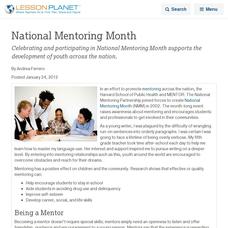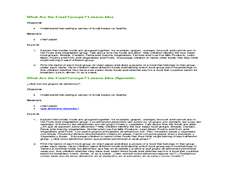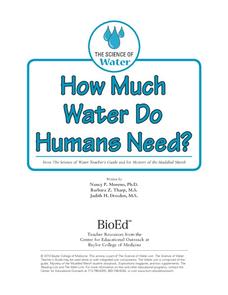Curated OER
Do As I Do
Lead your class in practicing gross motor body movements. Put on some background music and lead them through hops, skips, jumps, leaps, and running in place. Think of animal movements and have them move like an elephant or slither like a...
Curated OER
Visiting the Dentist
For this dental health worksheet, students see black line pictures of items that are used in the dental office. They can color a bib, a dental mirror, a dental car, mask, gloves, and an air syringe.
Curated OER
What's Ponytail's Big News?
Learners discuss reasons to not smoke. In this anti-smoking instructional activity, students listen to a story where the character Ponytail the pony doesn't smoke and is thus able to engage in physical activities. They create Ponytail's...
National Institute for Literacy
Making Sense of Decoding and Spelling
Go over digraphs, vowel sounds, and affixes with a series of decoding and spelling lessons. Each lesson guides learners through a different reading and phonics skill, building on the lesson before, and challenging them with each step.
Curated OER
Scrambled Eggs and Dead Bugs
Students practice movement by pretending be scrambled eggs, and dead bugs. They dance, skip, gallop, walk etc . . . when music plays, and stop when it does not.
Curated OER
Staying Healthy Year Round
Students are read a variety of books and observe the weather in the different seasons. In groups, they compare and contrast the type of activities people are doing. They also discuss how they adapt to the changes in seasons by the...
Curated OER
National Mentoring Month
Celebrating and participating in National Mentoring Month supports the development of youth across the nation.
Curated OER
Tattling and Telling
Students identify ways to prevent bullying. In this character education lesson, students discuss the difference between tattling and telling and perform a puppet show to illustrate these differences.
US Department of Homeland Security
Psychological First Aide (PFA) for Students and Teachers
Listen, protect, connect! Using the resource, teachers learn how psychological first aid helps scholars adjust after a crisis or school emergency. They discover how to observe changes in pupils' school performance, listen and offer...
Curated OER
What Are the Food Groups?
Young scholars discover the four main food groups by categorizing their own diet. In this healthy eating lesson, students utilize a chart with pictures of food to identify which food belongs in which food group. Young...
Curated OER
Brushing Your Teeth
Students use a shoe box to simulate what happens when candy gets between your teeth. In this teeth brushing lesson plan, students explore the importance of brushing your teeth. Students listen to Brush Your Teeth Please. Students...
Baylor College
What Makes Water Special?
Get close up and personal with a drop of water to discover how the polarity of its molecules affect its behavior. Elementary hydrologists split and combine water droplets, and also compare them to drops of oil. Much neater than placing a...
Baylor College
What Dissolves in Water?
One of water's claims to fame is as the universal solvent. Young physical scientists experiment to discover which materials dissolve in this special compound. You could never be more prepared for teaching this lesson than by using this...
Baylor College
There's Something in the Air
Clever! In order to compare indoor and outdoor dispersal rates for the movement of gases and particles through air, collaborators will participate in a classroom experiment. Set up a circular grid and set students on lines that are...
Baylor College
Dust Catchers
In class, your emerging environmentalists construct dust catchers. They take them home for a week or two, and then bring them back into class to examine under a magnifier. From this activity, they learn what makes up dust and that...
Curated OER
Feelings and Emotions
Students discuss and write about different feelings they or someone else may have. In this feelings lesson plan, students discuss different ways they express their feelings. Then they get a picture with someone who is demonstrating a...
US Environmental Protection Agency
Aquifer in a Cup
Young scientists create their very own aquifers in this science lesson on ground water. After learning about how some people get their drinking water from underground wells, young learners use sand, modeling clay, and aquarium rocks to...
Curated OER
Listening To The Prairie
Students investigate the concept of agriculture and how it is part of the ecology and economy of the United States. They participate in a number of different classroom activities intended to raise agricultural awareness. The activities...
Curated OER
Kodomo No Hi: Children's Day Celebration
Children's Day is a beloved Japanese holiday with many colorful and engaging traditions. On this national holiday celebrated yearly on May 5, children are honored for their strengths and given good wishes for happiness. Your younger...
Texas Center for Learning Disabilities
Teacher Templates
Letter by letter, sound by sound, monitor the growth of your emergent readers with these assessment templates. Adaptable to the needs of individual students, these one-on-one assessments focus on children's ability to identify...
Early Childhood Learning and Knowlege Center
My Body My Senses
In a comprehensive unit of activities, learners explore the five senses. Youngsters discover the many different body parts and their functions that allow humans to have sense of sight, touch, smell, taste, and hearing. The best way to...
Curated OER
Feelings
Students describe how they feel in different situations. In this feelings lesson plan, students respond to questions asked by the teacher while reading the book The Way I Feel. They also use mirrors to show look at their own faces while...
Baylor College
Do Plants Need Light?
Turn your classroom into a greenhouse with a lesson on plant growth. First, investigate the different parts of seeds, identifying the seed coat, cotyledon, and embryo. Then plant the seeds and watch them grow! Measure the new plants...
Baylor College
How Much Water Do Humans Need?
Physical or life science learners measure the amounts of water eliminated by intestines and the urinary system, and the amounts lost via respiration and perspiration. In doing so, they discover that the body's water must be replenished...
Other popular searches
- Public Health Issue
- Aids Public Health
- Public Health Care
- Black Death Public Health
- Public Health Week
- Epidemic Public Health
- Public Health Resources
- Public Health Needs
- Microbes and Public Health
- Public Health Lessons
- Public Health Pollution
- Public Health Service Message























